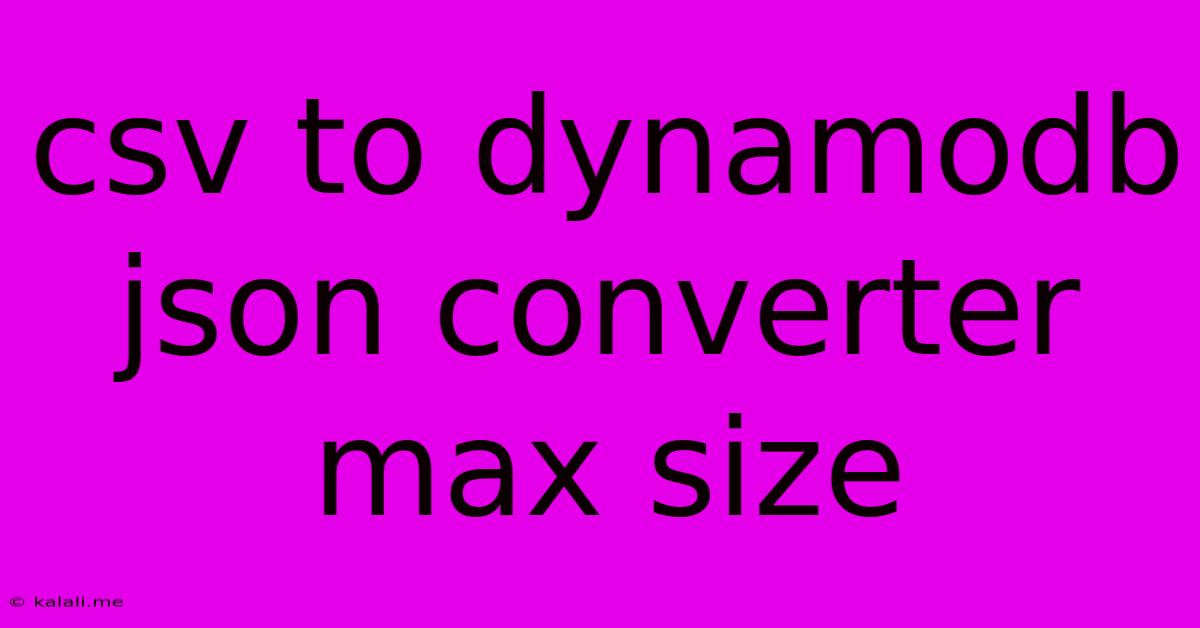Csv To Dynamodb Json Converter Max Size
Kalali
Jun 05, 2025 · 3 min read

Table of Contents
CSV to DynamoDB JSON Converter: Max Size Limitations and Solutions
Converting CSV data to DynamoDB JSON format is a common task for many data engineers and developers. However, a critical consideration is the maximum size of the CSV file you can efficiently process. This article explores the limitations and provides practical solutions for handling large CSV files when converting them to DynamoDB-compatible JSON. Understanding these limits is crucial for avoiding errors and ensuring smooth data migration.
Understanding the Constraints:
The maximum size of a CSV file you can convert directly to JSON without encountering issues depends on several factors:
-
Memory Limitations: The most significant factor is the available memory on your system (RAM). Loading a massive CSV file entirely into memory before processing it can lead to an
OutOfMemoryError. The larger the CSV, the higher the memory requirement. -
JSON File Size: While JSON is generally more compact than CSV, extremely large JSON files can still cause performance bottlenecks, especially during the upload process to DynamoDB. DynamoDB has limits on item size, impacting your ability to store excessively large JSON objects representing a single row from your CSV.
-
DynamoDB Item Size Limits: DynamoDB itself imposes a limit on the size of individual items. Exceeding this limit will result in an error. Therefore, pre-processing your CSV to ensure each converted JSON object (representing a row) stays within DynamoDB's constraints is crucial. This often involves splitting large rows or normalizing your data.
-
Processing Time: Larger CSV files naturally take longer to process and convert. This can impact the overall efficiency of your data migration pipeline.
Strategies for Handling Large CSV Files:
Several strategies can help overcome the size limitations:
1. Batch Processing:
This is the most effective approach. Instead of processing the entire CSV at once, break it into smaller, manageable chunks. Process each chunk separately, converting it to JSON and uploading it to DynamoDB. This minimizes memory usage and reduces the risk of errors. You can use tools or programming languages like Python with libraries such as csv and boto3 to implement this easily.
2. Streaming:
Instead of loading the entire CSV file into memory, process it line by line using a streaming approach. This drastically reduces memory consumption, making it ideal for handling exceptionally large files. Libraries in Python and other languages support this.
3. Data Normalization:
Before conversion, normalize your CSV data. This involves restructuring your data to reduce redundancy and improve data integrity. Normalizing often results in smaller JSON objects, fitting within DynamoDB's item size limits. This also enhances query performance in DynamoDB.
4. Data Partitioning:
Divide your CSV data into multiple smaller CSV files based on a relevant key (e.g., date, region). Process and upload each partitioned CSV file separately. This improves parallelization and reduces the load on your system.
5. Choosing Appropriate Data Types:
Using efficient data types in your JSON output can help reduce the overall size of the JSON documents. For instance, using integers instead of strings where appropriate can save space.
Tools and Technologies:
Various tools and technologies can assist in this conversion process:
- Python with
csvandboto3: A powerful combination for efficient CSV processing and DynamoDB interaction. - AWS Data Pipeline: A managed service for orchestrating data transformations and loading data into DynamoDB.
- AWS Glue: A serverless ETL service capable of handling large-scale data transformations.
- Other ETL tools: Many commercial and open-source ETL (Extract, Transform, Load) tools provide functionalities for CSV to JSON conversion and DynamoDB integration.
Conclusion:
Converting large CSV files to DynamoDB JSON requires careful planning and consideration of memory and processing limitations. Employing strategies like batch processing, streaming, data normalization, and partitioning ensures a smooth and efficient conversion process, regardless of the CSV file's size. Remember to always check DynamoDB's item size limits to prevent errors and optimize your data storage.
Latest Posts
Latest Posts
-
Why Does It Say That Mvn Is Not Installed Mac
Jun 06, 2025
-
Naming Generator For Landing Pages From Campaigns In Salaeforce
Jun 06, 2025
-
Do You Want To Try Some
Jun 06, 2025
-
Android How To Clear Data Usage
Jun 06, 2025
-
How To Get Client Id And Client Secret In Salesforce
Jun 06, 2025
Related Post
Thank you for visiting our website which covers about Csv To Dynamodb Json Converter Max Size . We hope the information provided has been useful to you. Feel free to contact us if you have any questions or need further assistance. See you next time and don't miss to bookmark.